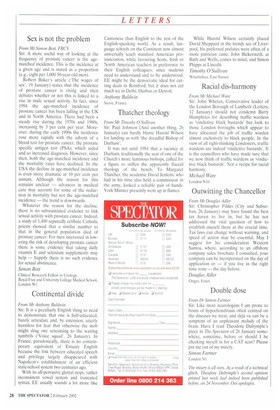Sex is not the problem
From Mr Simon Bott, FRCS Sir: A more useful way of looking at the frequency of prostate cancer is the agematched incidence. This is the incidence at a given age and is stated as a proportion (e.g., eight per 1,000 50-year-old men).
Robert Baker's article (`The wages of sex', 19 January) states that the incidence of prostate cancer is rising and then debates whether or not this is linked to a rise in male sexual activity. In fact, since 1994 the age-matched incidence of prostate cancer has been falling in the UK and in North America. There had been a steady rise during the 1970s and 1980s, increasing by 3 per cent per year. Moreover, during the early 1990s the incidence rose more rapidly with the advent of a blood test for prostate cancer, the prostate specific antigen test (PSA), which aided and so increased diagnosis. However, since then, both the age-matched incidence and the mortality rates have declined. In the USA the decline in age-matched incidence is even more dramatic at 10 per cent per annum. Although the reason for this remains unclear — advances in medical care may account for some of the reduction in mortality but not the age-matched incidence — the trend is downwards.
Whatever the reason for the decline. there is no substantiated evidence to link sexual activity with prostate cancer. Indeed, a study of 1,400 reputedly celibate Catholic priests showed that a similar number to that in the general population died of prostate cancer. For men interested in lowering the risk of developing prostate cancer there is some evidence that taking daily vitamin E and selenium supplements may help — happily there is no such evidence for sexual abstinence.
Simon Bott
Clinical Research Fellow in Urology.
Royal Free and University College Medical School, London WI






























































 Previous page
Previous page